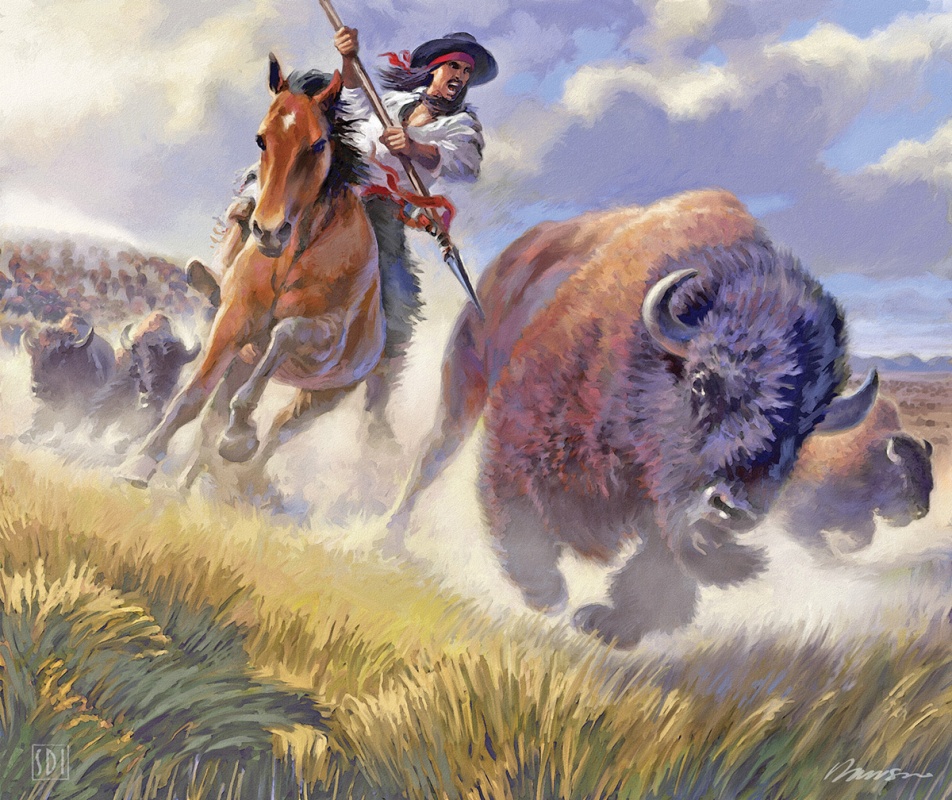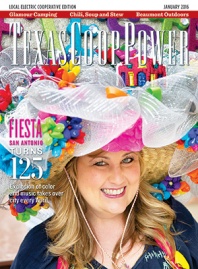Most 21st-century Texans would probably be surprised to learn that long before the Texas Panhandle was famous for cattle and oil—in fact long before the boundaries were drawn that made it the Panhandle—it was Far Eastern New Mexico to the Hispanic settlers along the upper Rio Grande. In the early 1700s, men and women from Taos, Santa Cruz, Chimayo and other villages north of Santa Fe began to venture out onto the eastern plains each year to hunt buffalo and occasionally trade with the Comanches who lived there. They were known as los ciboleros—the buffaloers—and the more sedentary settlers to the south thought they were absolute wild men. A ballad from the early 1800s describes “the people from Chimayo with their braided hair, who have left their looms.”
The ciboleros wore wide-bottomed, knee-length leather pants, high leather boots, leather jackets, and peaked leather caps with feathers in them and they carried eight-foot-long lances with foot-long iron tips as well as bows and arrows. Every fall, after the crops were harvested and when the buffalo were fat and the wool was thick on their hides, the ciboleros went out onto the plains on horseback, accompanied by ox-drawn carts which carried the dried meat and hides back to the settlements.
A single party of ciboleros might in-clude 150 men and women, 500 horses and pack mules, and 50 carts. Some of the nineteenth-century ciboleros who survived into the 1930s told Federal Writers’ Project interviewer Lorin Brown how the hunt worked. The men elected a leader, a comandante, who was in absolute charge of the group. When they spotted a herd of buffalo, the comandante called all the men together and had them recite the Apostles’ Creed. Then he gave the order to charge by shouting “Ave Maria Purisima!” and the hunters fanned out across the prairie, with the fastest horses and the most skilled hunters on the flanks. When the killing was over, the women helped to skin the buffalo and cut up and dry the meat. They frequently got as far as the Canadian River in the Panhandle and brought back an astonishing amount of meat and hides; an 1812 report estimated that the ciboleros killed 10,000 to 12,000 buffalo each year.
Sometimes the ciboleros brought back more than meat and hides. One of the more colorful characters around Santa Cruz in the nineteenth century was a man called El Guero Mestas, who died in his 80s about 1890. El Guero had blond hair and blue eyes—thus his nickname—and he had been brought to Santa Cruz as an infant by some ciboleros who had traded buffalo meat for him with a band of Comanches they had met in the breaks of the Canadian River. The Comanches had killed his parents and were taking him back to adopt into their tribe. Instead, he was adopted by a family named Mestas and grew up to be a prosperous farmer and prominent man in Santa Cruz, famous for his poetry, his practical jokes and his piercing blue eyes.
The ciboleros didn’t always get what they went after. Vicente Romero of Cordova told Lorin Brown about a trip he made to the Texas plains. He and his companions met up with a group of Comanches and camped with them to do some trading. The wife of one of the [natives] turned out to be a young Mexican girl from San Antonio, Texas, who had been taken captive a few years before. She pleaded with Romero to rescue her, and Romero considered the sensation it would cause at home if he brought the beautiful captive back as a bride. But the comandante told him, “No, it can’t be done. Any effort to free her might destroy our whole party.” When Romero’s friend Anaclete Mascarenas continued to argue with the comandante, he was seized and bound until he promised to obey the leader’s orders in everything. “So,” Romero concluded, “the pobrecita stayed there with the Indians, perhaps for life. Asi le toco [thus it happened].”
As the buffalo herds diminished, the ciboleros turned to trading with the Comanches, taking salt, tobacco, Navajo blankets, strips of iron, dried fruit and sacks of a hard bread called pan de Comanche out on the Texas plains and coming back with horses, stolen cattle and, sometimes, captives like El Guero Mestas. Santa Fe trader Josiah Gregg met a group of these traders on the plains in the 1820s and claimed that they spent so much time with the Comanches that they pointed at objects with their chins, like Indians, instead of with their fingers. By the 1850s and ’60s comancheros, as these traders were called, were meeting with Comanches at springs and creeks all over the Panhandle, and some people were unkind enough to say that they even accompanied their trading partners on raids to ranches in the Cross Timbers and the Hill Country so they could pick out the cattle they wanted.
In 1876 a former comanchero from Mora, Casimero Romero, decided to settle permanently in the Panhandle, and he brought his family, 100 servants, and 5,500 sheep to Atascosa Creek in Oldham County, where he built a big adobe house, dug irrigation ditches and gathered several other families from Mora and Las Vegas around him. He and his neighbors prospered as New Mexican sheep ranchers in Texas for a few years, but then cattlemen began to crowd them out and they pulled back across the plains to New Mexico and left the Panhandle to the cattlemen, who are still there. But the next time you drive to Lubbock, think not about ranchers and wildcatters, but about the ciboleros from Chimayo with their braided hair and leather jackets and lances.
——————–
Excerpted from Texas, My Texas: Musings of the Rambling Boy, TCU Press [Original column: September 14, 2006]


